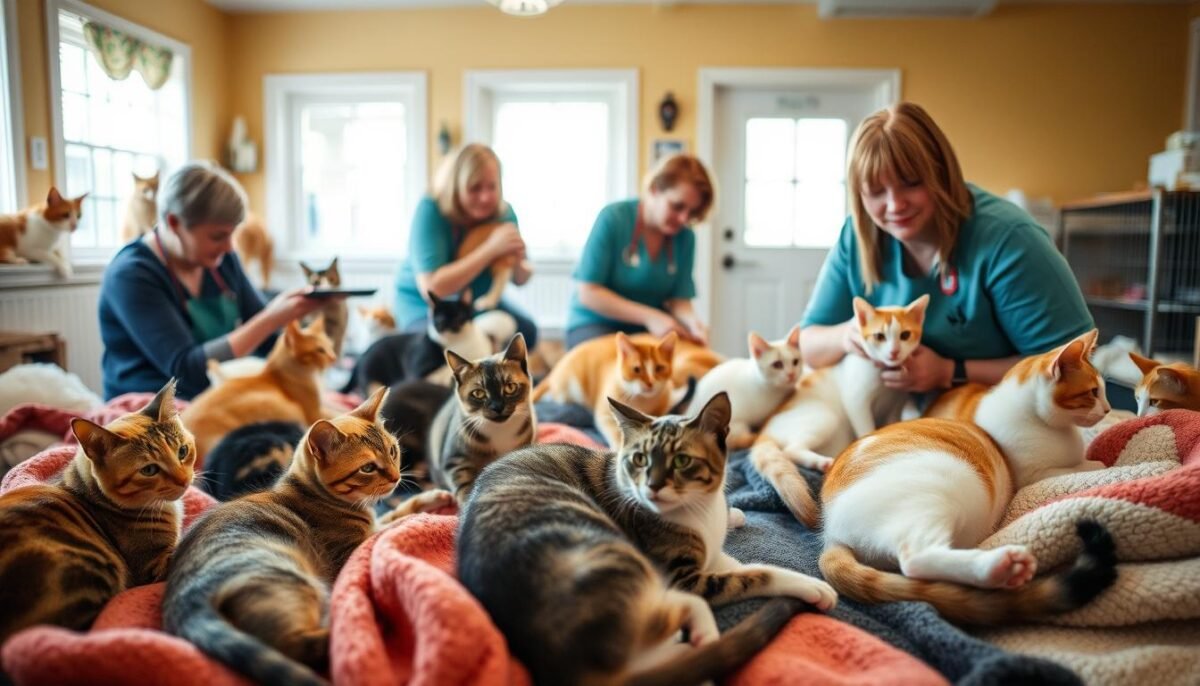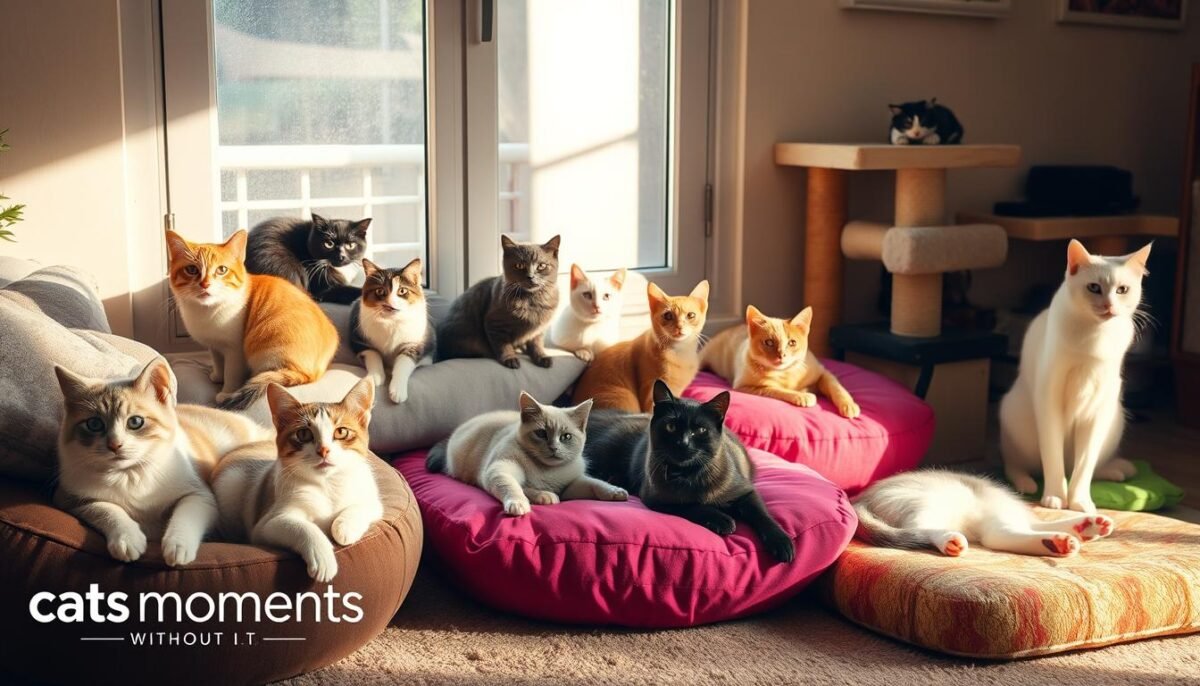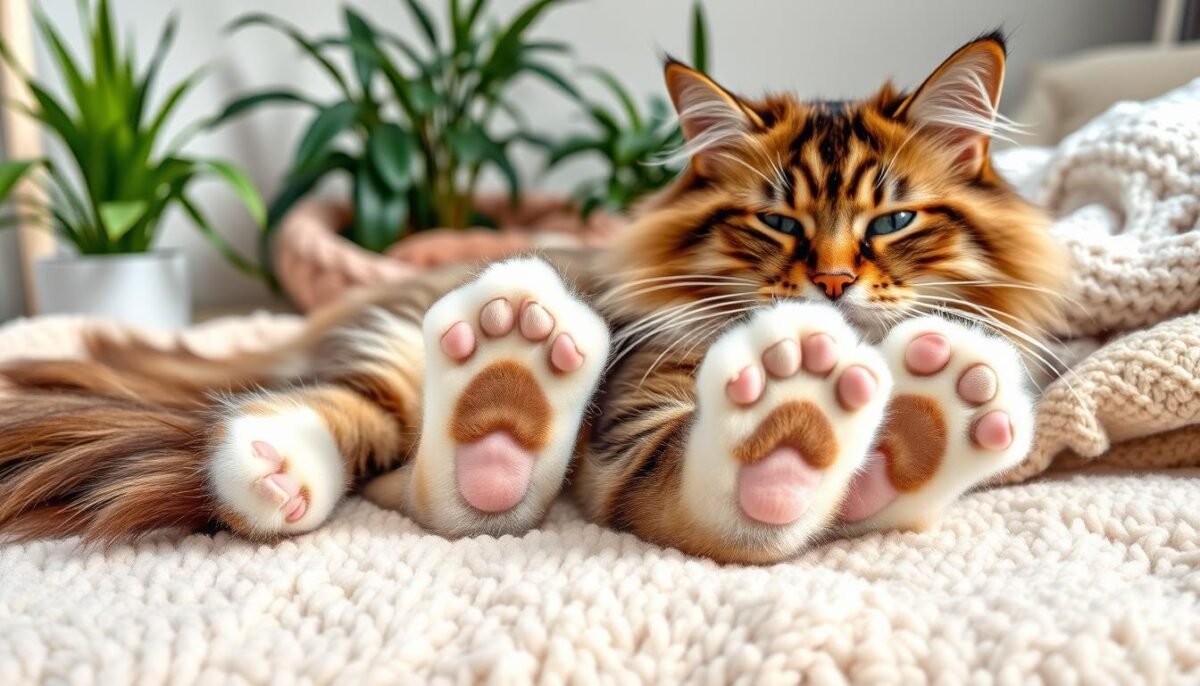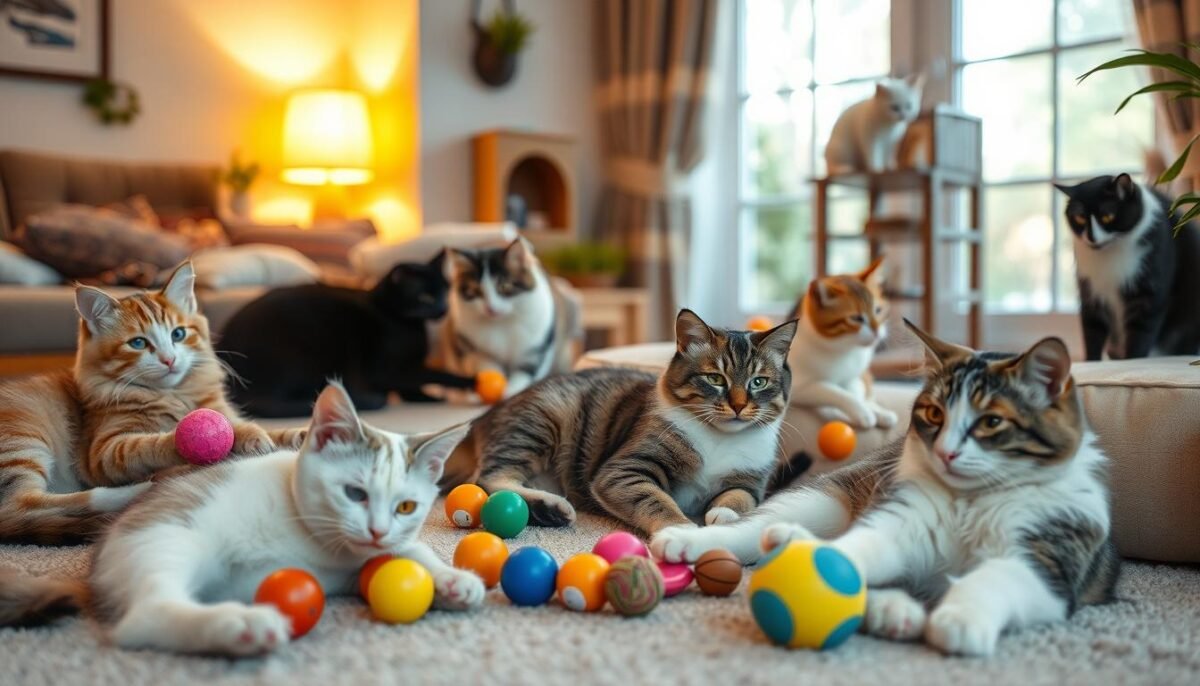Ever thought about the special needs of a declawed cat? It’s key to know how declawing affects a cat’s life. This guide will help you understand what it means to adopt a declawed cat. We’ll look at their needs and how to give them a loving home.
Key Takeaways
- Declawed cats have had their front claws removed, affecting their behavior and health.
- Many end up in shelters or rescues because owners don’t understand the procedure.
- Adopting a declawed cat means considering their special needs and creating a safe space.
- Training and enrichment can help them adjust and thrive in their new home.
- Spreading awareness about declawing can help fewer cats need adoption.
One big question is: What are the true implications of declawing, and how can I provide the best care for a declawed cat? By exploring this topic with an open and compassionate mindset, we can uncover the challenges and opportunities that come with welcoming a declawed feline into your home.
Understanding Declawing: What It Means for Cats
As pet owners, knowing the effects of declawing on cats is key. Declawing, or onychectomy, removes the last bone and nail of a cat’s toes. It might seem like a way to protect our homes, but it deeply affects a cat’s health and behavior.
The Declawing Procedure
The declawing surgery is complex and invasive. The vet removes the last bone and nail of each toe. This makes cats unable to scratch and changes their paw structure and function.
The recovery is painful and can lead to long-term issues. Cats might have trouble walking and feel more sensitive in their paws.
Impacts on Cat Behavior
Declawing can change a cat’s behavior a lot. Without claws, some cats become more aggressive, withdrawn, or avoid the litter box. They might also feel insecure and bite more as a defense.
It’s important for pet owners to watch for these changes. This way, they can care for their declawed cats better.
Common Misconceptions
Many think declawing is harmless. But it’s a major surgery with lasting effects on a cat’s health and happiness. It’s banned or restricted in many places because of animal welfare concerns.
“Declawing is a permanent and irreversible mutilation that can lead to a lifetime of pain and discomfort for the animal.”
For those considering adopting declawed cats, it’s crucial to understand this issue. Learning about feline paw care and the effects of declawing helps us make better choices. We can give the best homes to these special needs cat adoption cases.
Why Some Cats Are Declawed
Declawing cats is a complex issue. It’s important to know why it happens. The reasons often include bad beliefs or personal choices. These choices can harm the cat and its relationship with its owners.
Relinquishment Reasons
Cats in shelters often have been declawed. Owners might have thought it was harmless. But, it can hurt the cat’s health and behavior. When problems show up, owners might give up their pets.
Role of Cat Owners in Declawing
Many owners don’t understand declawing. They think it’s easy and won’t hurt their cat. But, it’s a serious surgery that can harm the cat for life.
Declawing and Shelter Admissions
Declawed cats often go to shelters. This is because of the problems declawing causes. Owners might not know how to handle these issues. They might give up their cats to shelters.

Understanding declawing helps us care for cats better. We can teach owners to make choices that help their cats. This way, we can make sure cats are well taken care of.
Benefits of Adopting Declawed Cats
Adopting a declawed cat can be very rewarding. It offers special benefits for those looking for a pet. These cats can fit well into many homes, making them a great choice.
Compatibility with Families
Declawed cats are great for families. They don’t have claws, so they’re less likely to hurt kids or damage things. They are loving and playful, adding joy to any home without the worry of scratched furniture.
Reduced Damage to Furniture
One big plus of having a declawed cat is they don’t damage furniture. They can’t scratch, so they won’t ruin your furniture or rugs. This is perfect for people who want a pet but don’t want to deal with scratched-up furniture.
Potential for Indoor Living
Declawed cats do well indoors. They’re perfect for people living in apartments or who prefer their pets to stay inside. They don’t need to scratch, so they can live happily in smaller spaces. This makes them a great choice for a safe, comfortable home.
Adopting a declawed cat brings more than just practical benefits. They can add joy, comfort, and companionship to your life. When looking at declawed cats for adoption, remember the special joys they can bring to your home.

How to Find Declawed Cats for Adoption
If you want to give a declawed cat a loving home, there are many ways to do it. You can check local animal shelters, online platforms, or dedicated rescue groups. We’ll show you how to find the right cat for you.
Utilizing Local Animal Shelters
Animal shelters have many cats, including declawed ones. Go to your local shelter or humane society to see if they have any. They really want to find good homes for these cats, so ask them.
Online Adoption Platforms
Online platforms have changed how we adopt pets. Sites like Petfinder and AdoptaPet let you search for declawed cats near you. They help you find cats that fit your home and lifestyle.
Networking with Rescues
Cat rescue groups, local or national, often have declawed cats. Contact these groups if you’re interested in adopting. They might suggest cats that are a great match for you.
By trying different ways, you’ll find a declawed cat that will love your home. With some effort, you can give a cat a happy forever home.
Assessing the Needs of Declawed Cats
Thinking about adopting a declawed cat? It’s key to know their special needs and how to keep them safe and happy. We’ll look at the important things to check before bringing a declawed cat home.
Behavioral Assessments
Declawed cats might act differently than those with claws. To make sure they fit well, we need to watch how they behave. This means seeing how they interact and move in a shelter or foster home.
By knowing their personality and habits, we can see if they match our family and lifestyle.
Understanding Health Considerations
Declawing can affect a cat’s health for a long time. We should watch for feline paw care issues, chronic pain, and changes in how they move. It’s important to talk to a vet about the cat’s health before adopting.
This way, we can give them the right care and make sure they’re happy and healthy in their new home.
By carefully checking a declawed cat’s behavior and health, we can make smart choices. This helps us give them the best life and a loving home.

Preparing Your Home for a Declawed Cat
Welcoming a declawed cat into your home needs special care. You want to make a safe, comfy, and paw-friendly space. We know how special these cats are and will help you get ready for their arrival.
Creating Safe Spaces
First, make sure your home has safe, cozy spots for your declawed cat. Without claws, they feel more vulnerable and might get anxious in big areas. Set up a snug room with comfy furniture, scratching posts, and places to hide.
This will make your new pet feel safe. It also helps them get used to their new home slowly.
Choosing the Right Cat Supplies
Choosing the right supplies is key for your cat’s happiness. Pick soft, padded bedding and litter boxes with low sides for their sensitive paws. Stay away from rough surfaces that might hurt them.
Get cat furniture and scratching posts with soft fabrics or carpets. Also, get lots of toys to keep their mind busy and prevent boredom without using their claws.
Introducing Your New Pet to Home
When it’s time to bring your cat home, do it slowly and carefully. Let them get used to new sights, sounds, and smells at their own pace. Give them treats and positive feedback to make them feel good about their new home.
Watch for signs of stress and give them a safe place to hide if needed. With patience and care, your declawed cat will feel safe and at home.
By making a safe space, choosing the right supplies, and introducing them carefully, you’re off to a great start. Remember, your cat’s happiness and comfort are the most important things as you welcome them into your family.
Behavior and Training for Declawed Cats
Adopting a declawed cat can be very rewarding. But, it’s key to know about the behavioral challenges they might face. Declawing, a procedure that removes a cat’s claws, can cause many issues. As pet owners, we must care for these cats and train them well.
Common Behavioral Issues
Declawed cats often have trouble with litter boxes. Without claws, they might not want to use them, leading to accidents. They might also become more aggressive, as claws are their main defense. With the right care and training, we can help them manage these issues.
Effective Training Techniques
To meet the needs of declawed cats, we suggest using various training methods. Regular feline paw care, like nail trims, can help them scratch naturally again. Giving them lots of scratching posts and making them positive places to scratch is also key.
Using Feliway, a synthetic pheromone, can help calm them down. Positive reinforcement, like treats and praise, is also great. It helps them learn good behaviors and builds trust with their owners.
By understanding the special needs of declawed cats and using humane practices, we can help them thrive. This way, they can bring joy and love into our lives.

“With patience, understanding, and the right training techniques, declawed cats can overcome behavioral challenges and find their forever homes.”
Promoting Awareness About Declawing
We must teach people about declawing’s effects on cats. By sharing the truth, we help others make better choices for their pets. This way, we can all support more humane treatment of animals.
Educating Potential Pet Owners
Teaching about declawing is key. We can work with cat rescue organizations and pet adoption centers. They can share info on safer options like nail care and scratching posts.
This knowledge helps people choose better for their cats. It’s about caring for their pets’ health and happiness.
Supporting Rescues and Shelters
Helping places that care for declawed cats is vital. Cat rescue organizations and pet adoption centers need our support. They give these cats a second chance at a happy life.
By volunteering or donating, we help these cats find homes. Our efforts make a big difference in their lives.
Together, we can change how we treat cats. By educating and supporting these organizations, we can ensure cats are loved and respected. Let’s work towards a future where declawing is no longer needed.
Real Stories: Declawed Cats and Their New Families
Adopting a declawed cat can be very rewarding. Our featured success stories show how cats overcome being declawed. They find loving homes and thrive in their new environments.
Adoption Success Stories
Mittens, a 7-year-old declawed cat, was surrendered to a local shelter. The Smith family adopted her, eager to give her a safe home. “Mittens has brought joy and laughter to our lives,” says Mrs. Smith. “She’s adapted well and is best friends with our daughter.”
Bella, a declawed cat rehomed several times, found her forever home with the Johnsons. “Bella was shy at first, but with patience and love, she’s become very affectionate and playful,” shares Mr. Johnson. “We’re grateful to have her.”
Challenges Faced and Overcome
Adopting a declawed cat comes with challenges, but the rewards are worth it. Adopters often face issues with litter box training or increased anxiety. But, with the right care, these challenges can be overcome.
Mary, a declawed cat owner, says, “When we first brought Oreo home, he was skittish and had trouble with the litter box. But with vet guidance and training, he’s now confident and content. Declawed cats deserve love and care just like any other pet.”
“Declawed cats may have unique needs, but they deserve just as much love and care as any other pet.”
The stories in this section show the resilience and adaptability of declawed cats. They also highlight the joy and fulfillment of giving a loving home to these special felines. We hope these experiences inspire more people to adopt declawed cats.
Resources for Declawed Cat Owners
Caring for a declawed cat needs special attention and the right resources. We want our feline friends to get the best care, even with unique needs from declawing. Luckily, many resources are available to help declawed cat owners create a safe and loving home for their pets.
Veterinary Care Options
Finding vets who know about declawed cats is crucial. Look for clinics that have experience with these pets. They can help with any issues after declawing, like paw sensitivity, and keep your cat healthy.
Support Groups and Forums
- Connecting with other declawed cat owners is very helpful. Online groups and forums let you share experiences and get advice from others facing similar challenges.
- These online spaces are great for talking about feline paw care, special needs cat adoption, and making your home paw-friendly.
- By joining this community, you can learn a lot, find solutions, and feel supported in caring for your declawed cat.
Dealing with a declawed cat’s needs can seem tough, but with the right help and a supportive community, you can make a paw-friendly home for your pet. Give your cat the special care they need, and they’ll show you love and companionship like no other.
Conclusion: Why Consider a Declawed Cat for Adoption
Adopting a declawed cat can be very rewarding. These cats need loving homes because of no fault of their own. By welcoming them, we give them care, comfort, and companionship.
Final Thoughts on Giving a Home
Declawed cats have special needs, but they can do well with the right care. We can make a safe, enriching space for them. This helps them overcome past challenges and start a new, happy life.
Encouragement to Adopt
If you’re thinking about getting a pet, consider a declawed cat. They have lots of love and joy to share. Your kindness can change their life for the better. Let’s work together to give these cats a second chance.
FAQ
What is the declawing procedure for cats?
Declawing is a surgery that removes a cat’s last digit, including bone and claw. It’s a debated practice that affects a cat’s health and behavior.
How does declawing affect cat behavior?
Declawing can make cats more aggressive and less likely to use litter boxes. They may also avoid scratching posts. This is because declawing takes away a key way for cats to express themselves and defend themselves.
Why are some cats declawed?
Owners often declaw cats to prevent damage to furniture. But, this is not a good reason. It can harm the cat’s health and well-being.
What are the benefits of adopting a declawed cat?
Declawed cats can be great pets for some homes. They are good for families or those who don’t want damaged furniture. They also do well indoors.
How can I find a declawed cat for adoption?
Look for declawed cats at local shelters or online. You can also reach out to cat rescue groups. These places can help you find a declawed cat to adopt.
What should I consider when preparing my home for a declawed cat?
Make your home safe and comfy for a declawed cat. Use soft surfaces and the right litter. Introduce the cat to their new home slowly.
How can I help promote awareness about declawing and its alternatives?
Teach others about declawing’s downsides and the better options. Talk about nail trims and scratching posts. Supporting shelters for declawed cats is also a good way to spread the word.






